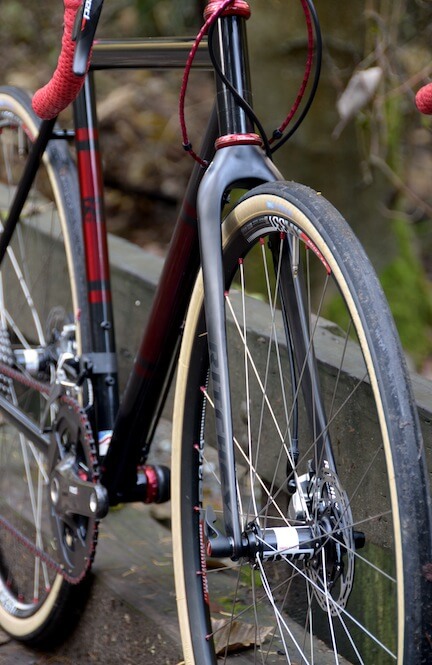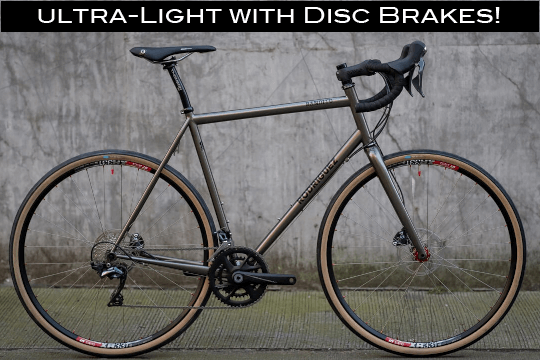
The Lightest Road Bike with Disc Brakes!
Unleash the Beast!
Since the introduction of the Outlaw in 2006, we here at Rodriguez have been known for building some of the lightest bikes on the road. The amazing thing about these bikes is that they are made of good ol' fashioned steel! Well actually, they are made of the New Steel. In 2006 we introduced our 13.5 pound Rodriguez Outlaw. That led to mass retirements of Trek Madone's, Cervelo R3's, Specialized Tarmac's, and many many other overseas-made carbon frames. We love the look on people's faces when they lift the Outlaw for the first time. Especially if they rode in on something they thought was 'really light'.
In 2016, we introduced something else spectacular. The Outlaw got a new cousin equipped with disc brakes, the Rodriguez Bandito. It took some time, and some planning to get the first Bandtio down to it's fly-weight of just 15.9 pounds. The lightest disc brake bikes that we've been able to verify weight on are at least 2 pounds heavier than the Bandito. Now, realize that not every Bandito we make is that light. Rider weight, riding style and component choices all have a big effect on the weight of the overall bike. But, as you can see, you don't have to ride carbon to get a light bike. The frame is really not the main factor when determining overall weight.
"The Rodriguez Bandito offers the serious weight weenie some never before seen features available on a fly-weight disc brake road bike!"
Fly-weight steel with disc brakes and 32c tires! First up: 35c Tires

Related Articles
Weight a Minute - Honesty in advertising
Steel vs. Carbon - Steel CAN be lighter
Chaos - Downside to abandoning ISO standards
The New Carbon... Carbon Steel!
Forever Bike - Proprietary parts :-(
The Bandito was the first ultra-light disc brake road bike designed for use with wider tires. As a matter of fact, we even did the weigh in with 32c tires on the bike. You can run up to 35c tires on this bike (If you want REALLY wide tires, check out the Phinney Ridge Model). We see the ability to run wider tires as the most important advantage to road disc brakes. Otherwise, why pay the weight penalty?
Next features: Lighter, more comfortable and more durable than your carbon bike
Now you won't have to compromise weight, ride quality, comfort, or durability to own the sweetest ride in the pack. The Banditio comes with our lifetime warranty, just like all of our steel bikes (most carbon bikes have just 5 year limited warranties). Steel has a well deserved reputation as the smoothest riding material, but also is thought of as heavy:-( This is because most of us owned heavy steel bikes back in the 1970's, and we associated the 'heft' with the frame material. We loved the ride, but were willing to sacrifice that smooth ride to save a few pounds on aluminum or carbon fiber. Well, steel has evolved, and now we can make a Rodriguez from steel that's lighter than it's carbon or aluminum counterparts. Some of you are probably ready to email us and schedule a test ride...right? Others out there, I know will be reading this and thinking "Bull Sh#$%" right? Well, read on then. I'll explain a few things that will help you understand how we can pull this off.
Bottoms up:
Now, let's talk about bottom brackets. This is the part of your frame that holds the bearings for your cranks. Needless to say, this is also also weak point on a carbon bike. It's a point of great stress on any frame. To fit the ultra-light, standard ISO bottom brackets that are used in steel, aluminum and titanium bikes, the carbon guys had to glue in a steel or aluminum shell so they could put threads in it. This added weight to a carbon frame. This was also a weak point as eventually the glue failed. To solve the problem, the carbon guys again abandoned the long held ISO standards, and adapted one of several different non-standards. Again, the frame had to be 'beefed up' and a heavier bottom bracket had to be used.
Let's compare:
This brings us to an interesting point. Whether intentional or not, these evolutions artificially make a carbon frame seem lighter than it is. If one weighs just the carbon frame, without it's required heavier bottom bracket and head set, the frame can be a little lighter than our steel Bandito. So a published frame weight is not the only thing to look at. If one weighs the carbon frame with it's fork, required head set, and required bottom bracket, the result will be quite different. You see, an ultra-light Rodriguez steel frame, you can still use ultra-light ISO standard parts. This means that you can run much lighter head sets and bottom brackets, and in some cases forks. The result is very similar weights, or often, a lighter combined weight for the Rodriguez ultra-light.
So, no more weighing just the frame. You need to weigh the entire bike, or at least the frame with it's bottom bracket, head set and fork to get a real comparison. If you do that, you'll find the secret behind the Rodriguez ultra-light steel bikes like the new Bandito.
In closing I'd like to say, if you love really light bikes, and you haven't ridden a custom, American hand-made Rodriguez ultra-light, DO before you spend money on a carbon frame mass-produced overseas. If you already own a carbon bike, we challenge you to come in for a ride...but be careful...most who do wind up on a Rodriguez.
Thanks for reading - Dan 11-2016







